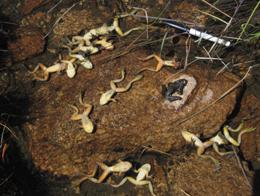 Fungal disease drives the loss of 30 species in
Fungal disease drives the loss of 30 species in
A Panamanian park has lost around 40% of its amphibian species in the past decade, with some dying out before biologists had even learned of their existence, according to research published today in the Proceedings of the National Academies of Science
"We're losing things before we find them," says Andrew Crawford, an evolutionary geneticist at the University of the Andes in
The disease chytridiomycosis, caused by the chytrid fungal pathogen Batrachochytrium dendrobatidis, threatens more than 2,800 amphibian species worldwide. Amphibians infected by the disease have skin several times thicker than normal, which affects their ability to breathe and the transfer of electrolytes.
A Panamanian park has lost around 40% of its amphibian species in the past decade, with some dying out before biologists had even learned of their existence, according to research published today in the Proceedings of the National Academies of Science
"We're losing things before we find them," says Andrew Crawford, an evolutionary geneticist at the University of the Andes in 
The disease chytridiomycosis, caused by the chytrid fungal pathogen Batrachochytrium dendrobatidis, threatens more than 2,800 amphibian species worldwide. Amphibians infected by the disease have skin several times thicker than normal, which affects their ability to breathe and the transfer of electrolytes.
Anticipating the arrival of B. dendrobatidis in
After sequencing toe clippings or liver samples from 297 specimens collected before the decline, the researchers found that the area was home to 63 known species. By using DNA barcoding — which involves sequencing standardized DNA marker fragments to match specimens with known species — Crawford and his co-workers identified a further 11 species that were previously unrecognized.
Thirty of these species are now extinct in the area, including "five that were wiped out before we even knew they were there", says Crawford. This brings the total loss of amphibian lineages to 41%. Naming a species that is already extinct was "pretty sobering", says Crawford.
Branching out
The researchers also looked at amphibian evolutionary history, which considers all the frogs,  salamanders and caecilians that have existed over millions of years.
salamanders and caecilians that have existed over millions of years.
Conservationists use species as a category to describe what needs protecting. The International Union for Conservation of Nature, based in Gland in
Crawford and his team mapped out the history and relationships — such as their common ancestors and when they split from other species — of all the species they found in the area. They found that 33% of all the branches in this evolutionary tree are gone — El Copé has lost 33% of the total history of all its amphibians.
"Up until now, we've only had a very crude estimate of what is lost. It has just been, 'We've lost a lot of species,'" says Vance Vredenburg, a biologist from
"What they did was quantify it," adds Vredenburg. "They took what we knew and added significance."
Crawford and his colleagues also looked at where extirpations occurred in the amphibian tree. Previous studies found patterns suggesting that some lineages and groups are hit harder than others, but in El Copé, the disease hit across the entire range of evolutionary history, wiping out some lineages and not others in a random way.
What now?
"The fungus is moving fast," says Crawford, who is conducting rapid surveys in the easternmost
Animals can be cured with anti-fungal solutions, but the problem is how to introduce healthy populations into the wild without causing reinfections. "There's a lot of hope, hypotheses and preliminary data, but no solution," says Crawford. In the meantime, herpetologists are attempting to preserve animals by removing them from their natural habitat. 
Another conservation method being explored is the use of probiotics3. Frogs and salamanders have symbiotic bacteria growing on their skin, defending them against the fungus. Vredenburg and his team are taking bacteria from healthy populations in the wild and culturing them in the lab — hoping to inoculate populations with heavy doses of their own beneficial bacteria, "to give them a big immune boost so that they have a fighting chance".
Amphibians are the oldest class of existing four-legged vertebrates, having been around for 300 million years. "Part of what's so alarming is that these long-term survivors are dropping off the face of the Earth right now," says Vredenburg.

 Previous page
Previous page Back to top
Back to top







